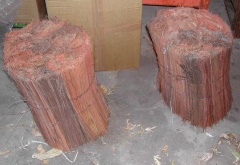Piassava
| Infobox on Piassava | |
|---|---|
| Example of Piassava |  |
| Facts | |
| Origin | - |
| Stowage factor (in m3/t) |
|
| Humidity / moisture | 16% |
| Ventilation | See text |
| Risk factors | See text |
Piassava
Description / Application
Piassava is a fibrous product of two Brazilian palms: Attalea funifera and Leopoldinia piassaba. Depending on quality, the resilient piassava fibers are processed into brooms and brushes. They are also made into mats and ropes.
Shipment / Storage / Risk factors
Piassava is shipped in bales or bundles. It is subject to loss in weight by drying out if packed in too wet a condition.
Contamination by moisture will make the fibre musty and liable to rot. When dried out it becomes brittle with loss of elasticity and depreciation of value. The product is flammable but not liable to spontaneous combustion.
If the product is loaded for shipment in a dry state, it does not have any particular ventilation requirements. Problems arise if the product, packaging and/or ceiling/flooring are too damp. In this case, the
air exchange rate should be 10 changes/hour (airing).
Piassava is sensitive to contamination by dust, dirt, fats/oils and rust as well as oil-containing goods, such as oil-bearing seeds/fruits, copra, raw wool etc., since oil-impregnated fibers promote self-heating/cargo fire. Holds or containers must accordingly be clean and in a thoroughly hygienic condition. Residues from previous cargoes, such as ores, stones, coal, metal filings, fertilizers etc., result in losses.











